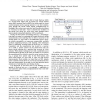91
Voted
CRYPTO
2007
Springer
15 years 6 months ago
2007
Springer
This work describes a mode of operation, TET, that turns a regular block cipher into a length-preserving enciphering scheme for messages of (almost) arbitrary length. When using a...
111
click to vote
CHES
2007
Springer
15 years 6 months ago
2007
Springer
Abstract. This paper discusses the state-of-the-art fast software implementation of block ciphers on Intel’s new microprocessor Core2, particularly concentrating on “bitslice i...
105
click to vote
CHES
2007
Springer
15 years 6 months ago
2007
Springer
With the establishment of the AES the need for new block ciphers has been greatly diminished; for almost all block cipher applications the AES is an excellent and preferred choice....
111
click to vote
DATE
2007
IEEE
15 years 7 months ago
2007
IEEE
Software implementations of modern block ciphers often require large lookup tables along with code size increasing optimizations like loop unrolling to reach peak performance on g...
114
click to vote
IEEEIAS
2008
IEEE
15 years 7 months ago
2008
IEEE
In this paper, we present the Dynamic Injection Model (DIM) and its variant the Static Injection Model (SIM). DIM is a model that allows any iterative block cipher to accept a var...
96
Voted
DSD
2008
IEEE
15 years 7 months ago
2008
IEEE
In this paper, we examine the digital hardware design and implementation of a novel compact block cipher, referred to as PUFFIN, that is suitable for embedded applications. An imp...
131
Voted
IWSEC
2009
Springer
15 years 7 months ago
2009
Springer
Impossible boomerang attack [5] (IBA) is a new variant of differential cryptanalysis against block ciphers. Evident from its name, it combines the ideas of both impossible differ...
107
click to vote
IMA
2009
Springer
15 years 7 months ago
2009
Springer
Abstract. We provide the first proof of security for Abreast-DM, one of the oldest and most wellknown constructions for turning a block cipher with n-bit block length and 2n-bit k...
ICICS
2009
Springer
15 years 7 months ago
2009
Springer
The overall structure is one of the most important properties of block ciphers. At present, the most common structures include Feistel structure, SP structure, MISTY structure, L-M...
126
Voted
FDTC
2009
Springer
15 years 7 months ago
2009
Springer
—Last year we were able to break KeeLoq, which is a 64 bit block cipher that is popular for remote keyless entry (RKE) systems. KeeLoq RKEs are widely used for access control pur...





